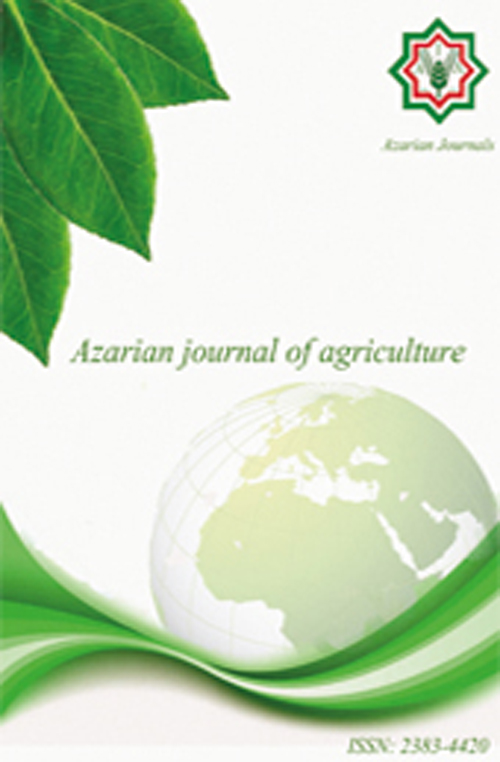فهرست مطالب

Azarian Journal of Agriculture
Volume:6 Issue: 2, Apr 2019
- تاریخ انتشار: 1398/03/04
- تعداد عناوین: 4
-
Pages 19-27The study ascertained ICTs and online resources used for meeting information needs by agricultural researchers and extension workers in Edo State, Nigeria. Survey design was used in the study. ICTs /online resources used by respondents to meet their information needs were: computers (95.1%), internet (90.2%), mobile/cell phones (86.3%), dictionaries (79.4%), electronic books (e-books) (78.4%), and electronic journals (e-journals) (77.5%). The majority (82.4%) indicated their purpose of using ICTS/online resources was for research purposes. Researchers acquired their e-resources majorly from the internet (83.9%) and extension workers acquired their e-resources through subscriptions made through the consortium for university and research libraries (87.5%). The study recommends that Edo State ministry of agriculture and agricultural research institutes in the state, should subscribe for online resources for the benefit of respondents who desire to use relevant online resources but are hindered by cost and technical issues.Keywords: Agricultural communication, agricultural extension, agricultural researchers, e-extension, extension workers, ICTs
-
Pages 28-36A field experiment was conducted at the Horticulture Farm of Agriculture and Forestry University, to determine the influence of different fertilizers and nematicides on the number of nematode galls (Meloidogyne spp.) and yield of okra (var. Arka Anamika) in summer season in Chitwan, Nepal. This experiment was carried out in a completely randomized block design (RCBD) which includes 7 treatments and 3 replications. The treatment included: goat manure, sesame (til) cake, mustard seed cake, poultry manure, Furacron (carbofuran), vermicompost and untreated control including only chemical fertilizer (NPK). All treatments were added to provide a sufficient amount of nitrogen required for the crop as per the recommendation. The remaining amount of required phosphorous and potassium was supplied by adding single super phosphate and muriate of potash, respectively. All treatments, except poultry manure had significantly superior germination at 7 days after seeding (DAS). Similarly, all treatments compared with control had significantly less gall index at 70 DAS; Furacron had least gall index at both 60DAS and 70DAS. The highest net profit was found in the case of poultry manure while the highest incremental cost-benefit ratio was obtained in Furacron. The highest yield (20t ha-1) and least number of galls were obtained in poultry manure which was as effective as a Furacron treatment. This experiment suggests the use of either poultry manure or Furacron, both of which will provide higher economic return and decrease the root-knot nematode in okra. However, use of carbofuran has recently been banned in Nepal.Keywords: furacron, galls manures, nematode, okra
-
Pages 37-45The aim of the research in field conditions was to establish grain yield and some yield components in three wheat varieties depending on seed size, 1.8, 2.0, 2.2, 2.5 and 2.8 mm, using split-plot method in four replications. The highest number of plants (477 and 518) per m2 was obtained from the 2.5 and 2.8 mm seed size, respectively. The largest number of spikes (561 and 532) per m2 was obtained from the 2.8 and 2.5 mm seed size, respectively. The highest coefficient of productive tillering of 1.39 was recorded in the 1.8 mm seed size. Remaining seed fractions (2.0, 2.2, 2.5 and 2.8 mm) gave significantly lower productive tillering. There were very significant differences in wheat grain yield over years, varieties, seed sizes and the year × seed size interactions. The highest wheat grain yields of 7.22 t ha-1 and 6.86 t ha-1 were achieved in the case of 2.5 and 2.2 mm seed sizes, respectively. A positive strong correlation was detected between the number of overwintered plants and the grain yield (r = 0.63**). Moreover a positive strong correlation was established between the number of spikes and the grain yield (r = 0.70**), while the negative weak correlation was recorded between the coefficient of productive tillering and the grain yield (r = -0.32**). With the same sowing norm, a large seed produces a significantly higher number of plants and spikes per m2 than small seed, which is important for the grain yield.Keywords: Grain yield, seed size, variety, wheat, year, yield components
-
Pages 47-57
The experiment was implemented at Sher-e-Bangla Agricultural University, Bangladesh to assess the effect of variety and vermicompost on the starch and sugar content activity of potato and their performance under ambient storage condition. The experiment consisted of two factors, i.e., factor A:- Potato varieties (V-4): V1: BARI TPS-1, V2: BARI Alu-28 (Lady Rosetta),V3: BARI Alu-25 (Asterix) and V4: BARI Alu-29 (Courage); factor B:-Vermicompost level (M-4): M1: 0 t ha-1 (Control), M2: 2 t ha-1, M3: 4 t ha-1 and M4: 6 t ha-1. Inferior quality is a major problem for potato production in Bangladesh. The application of vermicompost may enhance the processing quality of potato. The research revealed that vermicompost had a remarkable effect on most of the processing quality contributing parameters. Results also exhibited those processing parameters improved with increasing vermicompost level. Among the sixteen treatment combinations, Asterix with vermicompost at 6 t ha-1 showed the highest glucose, sucrose content. These two combinations also showed a little bit higher concentration of glucose and sucrose compared to those of other combinations. In case of ambient storage condition; starch decreased with increasing storing period while total soluble solids, glucose and sucrose increased with increasing duration up to 60 days after storage (DAS). Lady Rosetta and Asterix may keep under ambient storage condition up to 60 days after storage without decreasing any significant quality degradation just prior to tuber sprouting. The potato growers of Bangladesh may use Vermicompost on their potato field @ 6 t ha-1 for maintaining preferable good processing standard.
Keywords: Non-reducing sugar, Potato, Reducing sugar, Starch, Total soluble solid, Vermicompost

